Native
Clepsis clemensiana (Fernald) (Tortricidae: Tortricinae: Archipini)
Synonyms: nervosana (Tortrix)
FWLFWL:
forewing length; the distance from the base of the forewing to the apex, including fringe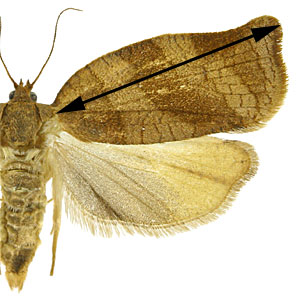 : 9.5-11.5 mm
: 9.5-11.5 mm
Forewings are straw yellow, narrow, and unmarked, although some females may have a faint reticulate pattern. The termentermen:
the outer edge of the forewing  is steeply angled creating an apexapex:
is steeply angled creating an apexapex:
the point furthest removed from the base or at the end of the costal area  that is nearly falcatefalcate:
that is nearly falcatefalcate:
narrow, curved and pointed; sickle-shaped; shaped like a bird's beak 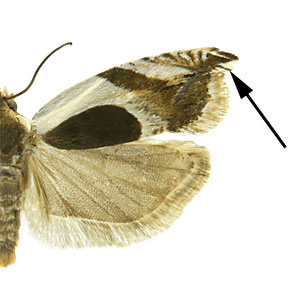 in some individuals. Hindwings are primarily white. Males have a forewing costal foldforewing costal fold:
in some individuals. Hindwings are primarily white. Males have a forewing costal foldforewing costal fold:
a flap or fold at the base of the forewing that contains specialized sex scales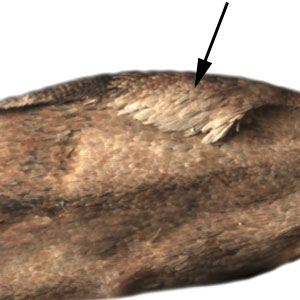 .
.
Male genitalia are characterized by a broad, short uncusuncus:
a sclerotized process which is fused to the posterodorsal margin of tergum IX ; reduced sociisocii:
; reduced sociisocii:
a pair of lightly sclerotized setose lobes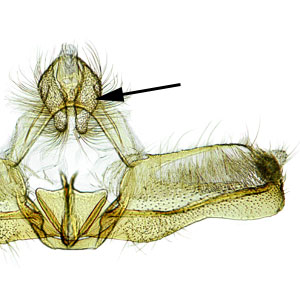 ; a robust tegumentegumen:
; a robust tegumentegumen:
dorsal section of the transverse ring in male genitalia; often heavily sclerotized 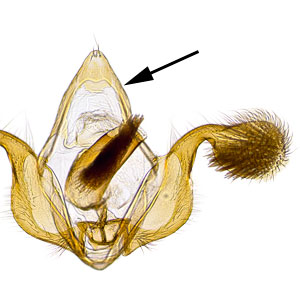 ; and an incomplete, finely spined transtilla. Female genitalia are characterized by a long, straight ductus bursae with a cestumcestum:
; and an incomplete, finely spined transtilla. Female genitalia are characterized by a long, straight ductus bursae with a cestumcestum:
a long, bandlike sclerotization of the wall of the ductus bursae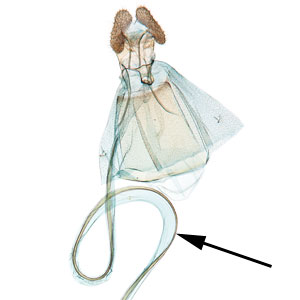 present; and a daggar-like signumsignum:
present; and a daggar-like signumsignum:
a sclerotized projection or patch on the interior of the corpus bursae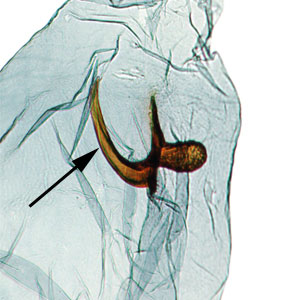 in the corpus bursaecorpus bursae:
in the corpus bursaecorpus bursae:
a dilated membranous sac at the anterior end of the bursa copulatrix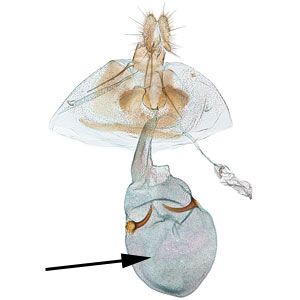 with a robust capitulumcapitulum:
with a robust capitulumcapitulum:
in reference to the female signum; a knoblike projection 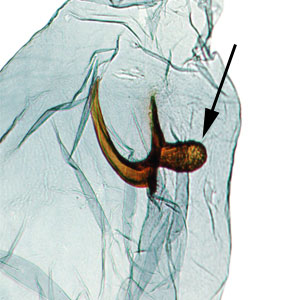 .
.
The following account is summarized from MacKay (1962a).
Mature larva approximately 10 mm in length; width of head 1.1-1.2 mm; head, prothoracic shieldprothoracic shield:
a sclerotized plate on the dorsal surface of the prothorax 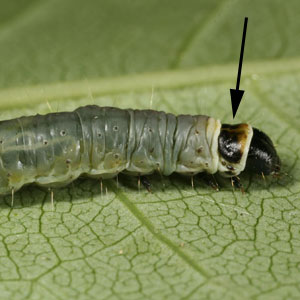 yellowish brown; legs, anal shieldanal shield:
yellowish brown; legs, anal shieldanal shield:
a sclerotized plate on the dorsal surface of the last abdominal segment (in larvae) 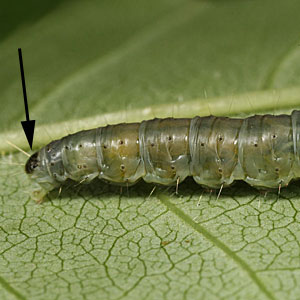 brown; pinaculapinaculum:
brown; pinaculapinaculum:
flattened sclerotized plates on a caterpillar that bear the setae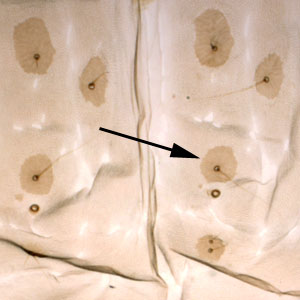 brown, large, conspicuous; anal fork well-developed; SV group on A1, 2, 7, 8, 9 numbering 3:3:3:2:2.
brown, large, conspicuous; anal fork well-developed; SV group on A1, 2, 7, 8, 9 numbering 3:3:3:2:2.
Detailed figures of larval chaetotaxychaetotaxy:
the arrangement of setae (in reference to Lepidoptera larvae), often depicted on a "setal map"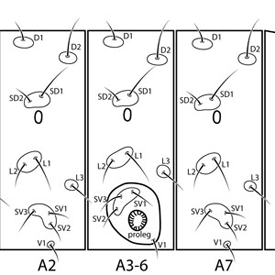 are available in MacKay (1962a).
are available in MacKay (1962a).
Xenotemna pallorana is similar but can be distinguished from C. clemensiana by the lack of a forewing costal foldforewing costal fold:
a flap or fold at the base of the forewing that contains specialized sex scales , a rounded termentermen:
, a rounded termentermen:
the outer edge of the forewing  on the forewing, and brownish or shaded hindwings. Genitalia of these two species are distinct and a dissection can be used to confirm identity.
on the forewing, and brownish or shaded hindwings. Genitalia of these two species are distinct and a dissection can be used to confirm identity.
The following account is summarized from Powell (1964b).
Clepsis clemensiana completes one or two annual generations. Adults are present in June and July and again in September for the second generation. Larvae feed on leaves of the host plants. Pupation occurs in a silk tube.
Grasses (Poaceae) are considered to be the primary host for Clepsis clemensiana, although the larvae have been reported feeding on plants in several other families.
| Host plant | Host plant family | Reference(s) |
| Apocynum sp. | Apocynaceae | LACM IndexLACM Index: LACM Index. Records from the card file at the Los Angeles County Museum of Natural History, Los Angeles, California; transcribed by Gaeden Robinson (BMNH). |
| Aster sp. | Asteraceae | Putman 1935Putman 1935: Putman, W. L. 1935. Notes on the hosts and parasites of some lepidopterous larvae. Canadian Entomologist. 67: 105-109. |
| Solidago sp. | Asteraceae | LACM IndexLACM Index: LACM Index. Records from the card file at the Los Angeles County Museum of Natural History, Los Angeles, California; transcribed by Gaeden Robinson (BMNH).; Putman 1935Putman 1935: Putman, W. L. 1935. Notes on the hosts and parasites of some lepidopterous larvae. Canadian Entomologist. 67: 105-109.; Freeman 1958Freeman 1958: Freeman, T. N. 1958. The Archipinae of North America (Lepidoptera: Tortricidae). Canadian Entomologist, Supplement 7 (Vol. 90): 1-89. |
| Symphyotrichum novae-angliae | Asteraceae | LACM IndexLACM Index: LACM Index. Records from the card file at the Los Angeles County Museum of Natural History, Los Angeles, California; transcribed by Gaeden Robinson (BMNH). |
| [unspecified] | Poaceae | Freeman 1958Freeman 1958: Freeman, T. N. 1958. The Archipinae of North America (Lepidoptera: Tortricidae). Canadian Entomologist, Supplement 7 (Vol. 90): 1-89. |
| Phleum pratense | Poaceae | Powell 1964bPowell 1964b: Powell, J. A. 1964b. Biological and taxonomic studies on tortricine moths, with reference to the species in California. University of California Publications in Entomology. Vol. 32. 317 pp. |
| Triticum aestivum | Poaceae | LACM IndexLACM Index: LACM Index. Records from the card file at the Los Angeles County Museum of Natural History, Los Angeles, California; transcribed by Gaeden Robinson (BMNH). |
| Malus sp. | Rosaceae | Hatch 1938Hatch 1938: Hatch, M. H. 1938. A bibliographic catalogue of the injurious arachnids and insects of Washington. University of Washington Publications in Biology. 1: 163-224. |
View full screen host table here
Clepsis clemensiana is widely distributed from the Northeast west to British Columbia, south to California, New Mexico, Missouri, and Tennessee.